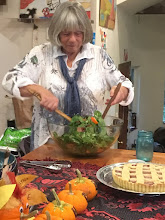One day last summer on a hike in the Red Buttes Wilderness Area, I had a hard-boiled egg for lunch. Maybe the spectacular setting, fresh mountain air, and good exercise influenced my taste perceptions, but I couldn't stop exclaiming over how good that egg was. Finally one of my hiking partners asked if that egg was really any different from any other.
Well, yes, as a matter of fact, it was. I buy my eggs, in season, from Bill and Mary, down the road. They have a mingled flock of several breeds, about 60 chickens in a large fenced-in yard to keep dogs and foxes at bay. The roosters strut about the yard with their sleek iridescent black tails gracefully arched and their necks protectively stretched as chickens cluck and peck around them. These days the chickens give about three dozen eggs a day. Pretty soon that'll be up to five dozen. Bill complains when customers buy more than a dozen eggs at once, leaving none for the next customer.
"It seems they would want to buy another dozen later, anyway," I said, "to have fresher eggs." Bill agreed but said that even two weeks later, these eggs are more fresh than anything you could buy in a supermarket.
Their shells range from creamy white to deep beige to pale green. When I break an egg into a dish, the dark yellow yolk domes high in the translucent white. My scrambled eggs are a deep yellow. Over-easy eggs keep a thick yolk that runs creamy over toast. Bill told me about one customer who uses the eggs to make pasta. "The pasta is so yellow people ask if she put food coloring in it," he told me.
In the eighteenth century a chef was not considered worth his salt unless he could cook eggs a hundred ways. Could I do that? I came up with about thirty ways—various ways to fry, boil, scramble, poach, or coddle eggs; recipes for soufflés, quiches, timbales, meringues, and custards. At that point, out of ideas, I consulted the cookbooks.
In The Joy of Cooking I found that if I whipped egg whites and baked them with the yolks inserted in indentations, I would have eggs in a nest. My Horizon Cookbook and Illustrated History of Eating and Drinking through the Ages gives a recipe for marbleized tea eggs (boil the eggs, crack their shells, reboil the eggs in their cracked shells in tea) and one for Scotch woodcock, a rich concoction of butter, cream and egg yolks that is, the editors claim, "no less delectable for want of a genuine woodcock." The same cookbook has a recipe for the beautiful-sounding oeufs a la neige: snow-eggs.
How many ways is that? Maybe if I count asparagus quiche different from broccoli quiche, ginger soufflé from cheese soufflé, and so forth, and if I add things like chess pie and angel food cake, which aren't included among egg recipes but might count because they are mostly eggs, maybe I could think of a hundred ways to cook an egg. But however I cooked it, I would know that, if I used eggs from the farm, all those dishes would have all diners exclaiming, "How good that was!"
Next week: "Confessions of a Picky Eater"
Recipes from this post:
Eggs in a nest
Oeufs a la neige
EGGS IN A NEST
(from Joy of Cooking, by Irma S. Rombauer and Marion Rombauer Becker)
serves 1-2
Ingredients
2 eggs
Salt and pepper
chives (optional)
Preparation
Preheat oven to 350º. Separate the eggs. Chop the chives. Butter a small ovenproof dish.
To make
Beat the egg whites till very stiff, then transfer them to the buttered dish. In the center of this mound make two indentations. Slip the egg yolks into these cavities. Bake until the eggs are set, about 10 minutes. Season with salt and pepper and sprinkle with chopped chives to enhance the presentation.
OEUFS A LA NEIGE
(I haven't actually made this recipe, but it sounds so good I thought I would pass it on to you, from the Horizon Cookbook and Illustrated History of Eating and Drinking through the Ages.)
serves 5-6
Ingredients
5 eggs
1/4 teaspoon cream of tartar
1/4 teaspoon salt
1 1/4 teaspoons sugar
2 cups milk
1 2-inch piece vanilla bean (or 2 teaspoons vanilla extract)
2 tablespoons cognac or rum (optional)
Preparation
Separate the eggs. Scald the milk in a deep, wide saucepan. Prepare a double boiler with simmering water.
To make
Beat egg whites with cream of tartar and salt to the point of soft peaks. Beat in 3/4 of a cup of sugar, 2 tablespoons at a time, to make a very thick and stiff meringue. In the scalded milk add 3 tablespoons of sugar and the vanilla bean. Shape the meringues with a large tablespoon and poach in the milk over a very low heat for about 3 minutes. Use two forks to turn them gently and continue poaching on that side. Remove with a slotted spoon to a serving dish.
Beat the egg yolks until very thick and pour into the hot milk in a thin stream, beating constantly. Scrape vanilla seeds into the custard, or, if you're using the extract, add it now. Cook the custard in the top of a double boiler over 1 inch of barely simmering water, stirring with your favorite wooden spoon until the mixtures coats the spoon.
Cool. Add cognac and pour around the meringues. Caramelize the remaining sugar and dribble it over the meringues.

No comments:
Post a Comment